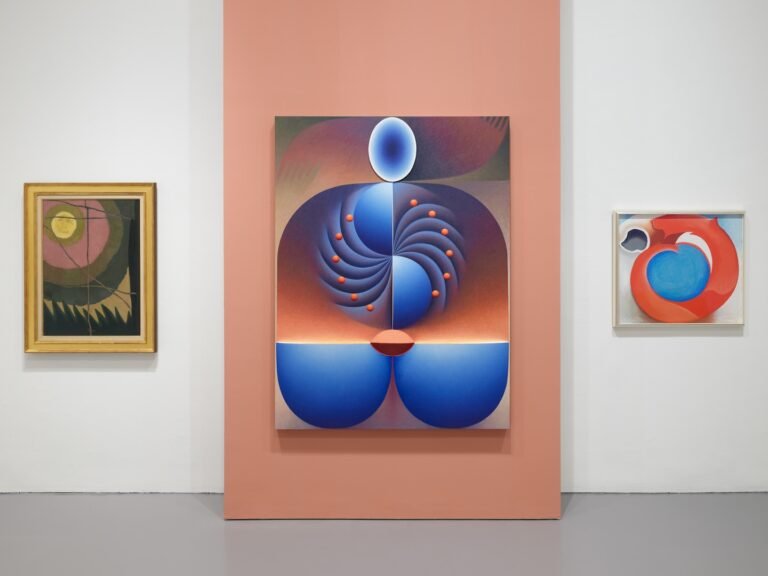No doubt, the Joseph H. Hirshhorn Museum and Sculpture Garden has a collection that can stand up to any of them. His bequest to the Smithsonian Institution in 1966 comprised almost 6,000 paintings and sculptures by the 19th and 20th centuries’ most vital artists — a figure that doubled with a gift of his remaining works upon his death in 1981.
But rarely is very much of it on view. Especially over the past decade or so, the museum has learned to love its Gordon Bunshaft-designed building, mounting ambitious installations that sometimes take up an entire minor arc of the Brutalist doughnut.
So the museum’s 50th anniversary this year is an opportunity to step back and see the collection in its original light. A chance to look back on the collection’s most important pictures, perhaps a moment to highlight new scholarship in art history or achievements in conservation. But the Hirshhorn’s not like other museums in town — and for its 50th birthday, the museum is throwing a bash.
“Revolutions: Art from the Hirshhorn Collection, 1860-1960” is a delightful romp through the permanent collection, featuring a gobsmacking number of artworks. The first of three planned anniversary exhibitions, this one focuses on modernism in all its lights, exploring the period through a truly maximalist presentation of paintings and sculpture. Better than a greatest-hits exhibition, “Revolutions” remixes the museum’s best B-sides and rarities, while still making a case about the long 20th century in art.
From Grandma Moses to Rashid Johnson, “Revolutions” spans a ludicrous range of painters. Right from the start, the show dials up the contrasts: The first works to greet viewers are a stately 1884 portrait by society painter John Singer Sargent hanging next to an electric 2020 portrait by Ghanaian star Amoako Boafo. Roughly speaking, these works could serve as chronological capstones for the Hirshhorn’s collection. But there’s something else to this pairing: It’s an unlikely diptych that tees up the push-and-pull between figuration and abstraction that defines the collection — and the century.
Curated by the Hirshhorn’s Marina Isgro and Betsy Johnson, “Revolutions” is chockablock with artworks. More than 200 paintings, sculptures and drawings — with the odd photograph thrown in, and a plan to rotate some artworks — trace the flow of ideas from early modernism to the postwar era. That’s a ton of work: For comparison, when the museum mounted a collection show in 2016, it included some 75 pieces.
The first gallery alone showcases a couple dozen works, including a salon-style hang of portraits by the likes of Édouard Vuillard, Thomas Eakins and Mary Cassatt. The show is chronological-ish, with contemporary works (like Boafo’s “Cobalt Blue Dress”) sprinkled throughout to break the very light logic of the show’s organization. The rooms have themes, but these are subordinate to the show’s overall flow, which focuses on pairings and dialogues. Artworks wink at one another from across decades and continents, like the geometric Lakota beadwork painting by Dyani White Hawk from 2022 hanging amid constructivist compositions by László Moholy-Nagy and Nadia Léger originally made a century earlier.
Contemporary selections such as Boafo and White Hawk emphasize and sometimes upend ideas in the collection. They’re just infrequent enough in “Revolutions” that they pop like exclamation points. Loie Hollowell’s three-dimensional painting “Boob Wheel” (2019) is an abstraction of the figure rooted in the artist’s own pregnancy, adding a maternal element (and a shade of sex) to the gallery. Nathaniel Mary Quinn’s “Literacy Lab” (2019), a multimedia piece that looks like three different drawings for an “exquisite corpse” — in fact, it’s just a single composition — holds its own alongside two cubist paintings by Picasso.
While it’s a busy painting show, sculpture takes center stage in “Revolutions,” part of a concerted effort to put more shine on the museum’s sculptural holdings, including the magnificent bronzes in the sculpture garden (currently undergoing a renovation). For the exhibit, the Hirshhorn has revived the light well, a vintage solution for displaying sculpture by placing works on an elevated podium under even, suspended lighting. These retro displays put a spotlight on works by Barbara Hepworth, Jean Arp, Max Ernst and more — smaller sculptures that are easy to overlook in any setting. One of the most magical groupings in the show is a wall-size vitrine that features delicate suprematist marionettes by Aleksandra Exster, futurist flower sculptures by Giacomo Balla and a peerless dada painting by Sonia Delaunay.
Isgro and Johnson find a few chances within the permanent collection to rattle long-standing dogma in art history: for example, by hanging a 1945 painting by the mercurial and long-overlooked artist Janet Sobel that predates the remarkably similar 1949 piece by Jackson Pollock nearby. Throughout the show, the curators elevate marginalized voices without being pedantic about it. Mid-century works by Haitian artists Rigaud Benoit, Hector Hyppolite and Castera Bazile occupy the same kind of space as Willem de Kooning.
In some ways, the Hirshhorn of “Revolutions” is the one I want to visit over and over. There is far too much great work from the 20th century locked away in the vaults of collections like this one. Fernand Léger’s “Nude on a Red Background” (1927) should never be put out of sight. And why condemn Balla’s futurist flowers to wither in the dark? Yet dynamic new artworks such as Torkwase Dyson’s “Bird and Lava #4” (2021) and Flora Yukhnovich’s “Lipstick, Lip Gloss, Hickeys Too” (2022), shown in context with the entire collection, make the case that the central ideas animating the 20th century still have juice. History never ends and all that, but Isgro and Johnson are pressing a more specific point, that the Hirshhorn museum continues to trace the loops and echoes of the many modernisms Joseph Hirshhorn followed from the start.
Maybe the most surprising moment comes at the very beginning. Looking at the Boafo-Sargent pairing by the entrance, to the right and almost behind the viewer stands Constantin Brancusi’s “Torso of a Young Man” (1924). A Futurist Manifesto-grade sculpture with this mega-wattage would normally hold pride of place in any collection. Here, it’s presented in an ambiguous position: possibly an anchor, possibly an afterthought. It’s as if to say the museum is still investigating what the 20th century means and how the pieces fit together, a project with no end in sight.
Revolutions: Art from the Hirshhorn Collection, 1860-1960
Independence Avenue and Seventh Street. hirshhorn.si.edu.
Dates: Through April 20, 2025.

